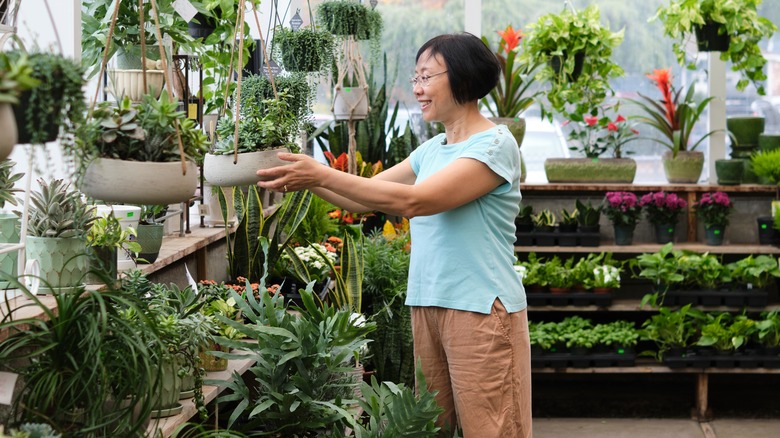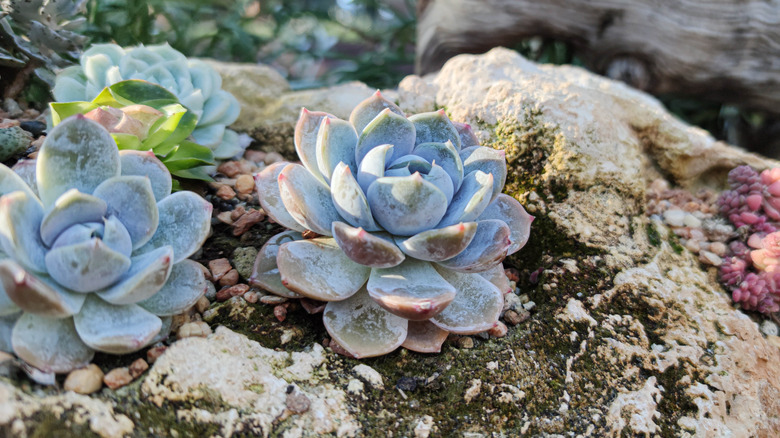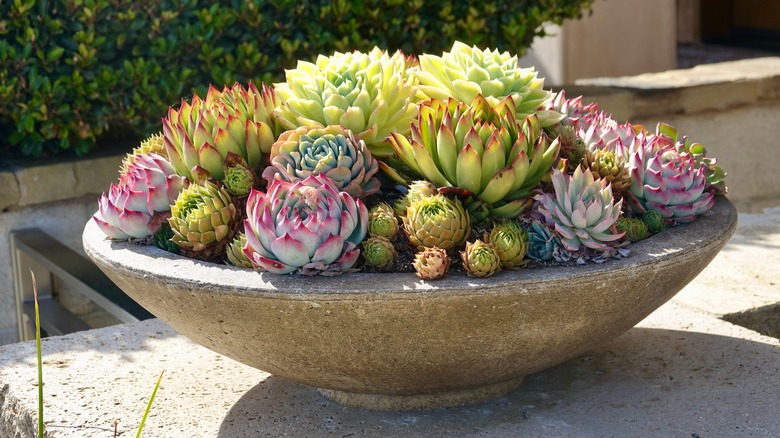The Drought-Tolerant Succulent That Looks Beautiful In Outdoor Planters
We may receive a commission on purchases made from links.
If you live in an area that receives spotty or unreliable rainfall, then you know how difficult it can be to plan your garden. Pinterest and Instagram are filled with landscaping ideas that hinge on sprawling grassy lawns and lush flower beds, and while they're beautiful, they rely on frequent and routine watering. But just because you live in a drought-prone area with watering restrictions doesn't mean you have to have a lackluster yard. Instead, you should shift your focus to planting drought resistant plants that thrive without much water. One such option is the hens and chicks succulent.
They require very little maintenance and thrive in what most plants would consider difficult conditions. Rather than needing loads of water to grow, these charming succulents prefer well-draining soil and full sun. Because of this, they're the perfect pick for front and back yards in hot regions that receive sporadic rain. You can plant them directly into the ground or arrange them in attractive planters. If going the planter route, they're the perfect succulent to spruce up an entryway or a patio. If this sounds like something you'd like to add to your landscaping, read on to see how to pull it off.
How often to water hens and chicks
Hens and chicks are alpine plants, which means they grow above the tree line, aka in mountainous regions. This is what makes it so hardy. It can not only grow in very little dirt or poor soil, but it can also survive long stretches of drought. You're actually better off forgetting to water this succulent than overwatering it, as the latter leads to root rot and an unhappy, mushy plant. So, how often should you water them? Well, it depends on the weather and where you plant them. If you have them in a container in a dappled shade that keeps the worst of the midday sun off its leaves, then you can water them once every one to two weeks. If it's peak summer with high temperatures and you planted them in a container without shade, you might need to water them more frequently.
However, if it's winter or you have high humidity for some time, you will want to cut back on watering so you don't accidentally over-water the succulent, which will cause it to wilt and die. The best way to determine when to water this succulent is to test the soil. Either poke a finger into the ground to see if it's still moist or invest in a moisture meter, such as the Hydrofarm Moisture Meter on Amazon for $13. If the soil is dry, it's time for a drink. If it's moist, wait several days before checking again.
Where to plant hens and chicks
Since hens and chicks are so hardy, you can plant them virtually anywhere in your yard. They are a fantastic addition to rock gardens — perfect for drought-prone areas — but they also look great in planters and terrariums. If you want to DIY a thriving succulent planter, doing so is easy. Since they're alpine and are used to a rockier terrain, use a gritty cacti or succulent dirt mix. These mixes usually contain elements like gravel, sand, or perlite, which helps water drain easier and ensures it doesn't water-log the dirt. Since these succulents hate wet feet, using such a mix is ideal.
As for where to put the planter in your landscaping, look for a sunny area that gets between four to six hours of direct light. This will ensure the rosettes stay happy and healthy. If you notice the leaves stretching towards a light source or fading in color, that's a telltale sign they need more sunshine, and the planter needs to be moved to a better spot. However, while it's not difficult to care for hens and chicks, they aren't indestructible. If you notice the leaves are getting scorched or sunburned, consider adding a shade cloth during peak summer to protect their leaves, such as this Greenhouse Garden Shade Cover for $10 on Amazon.


